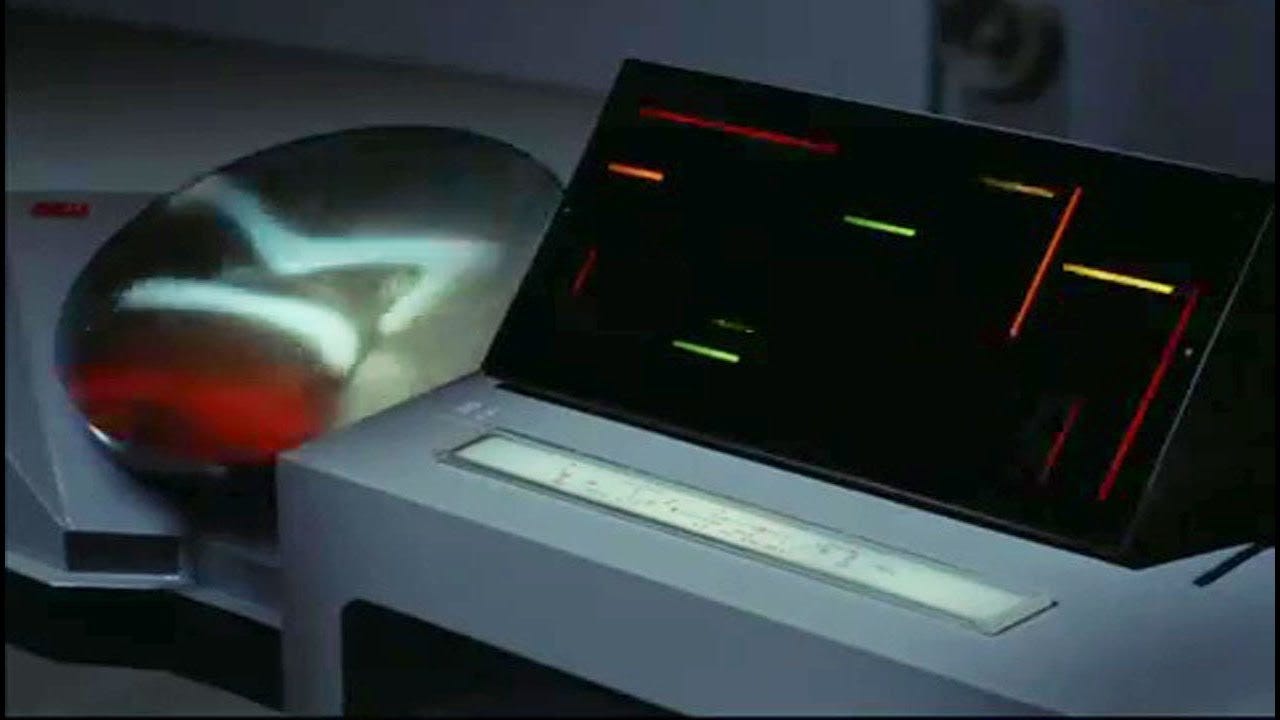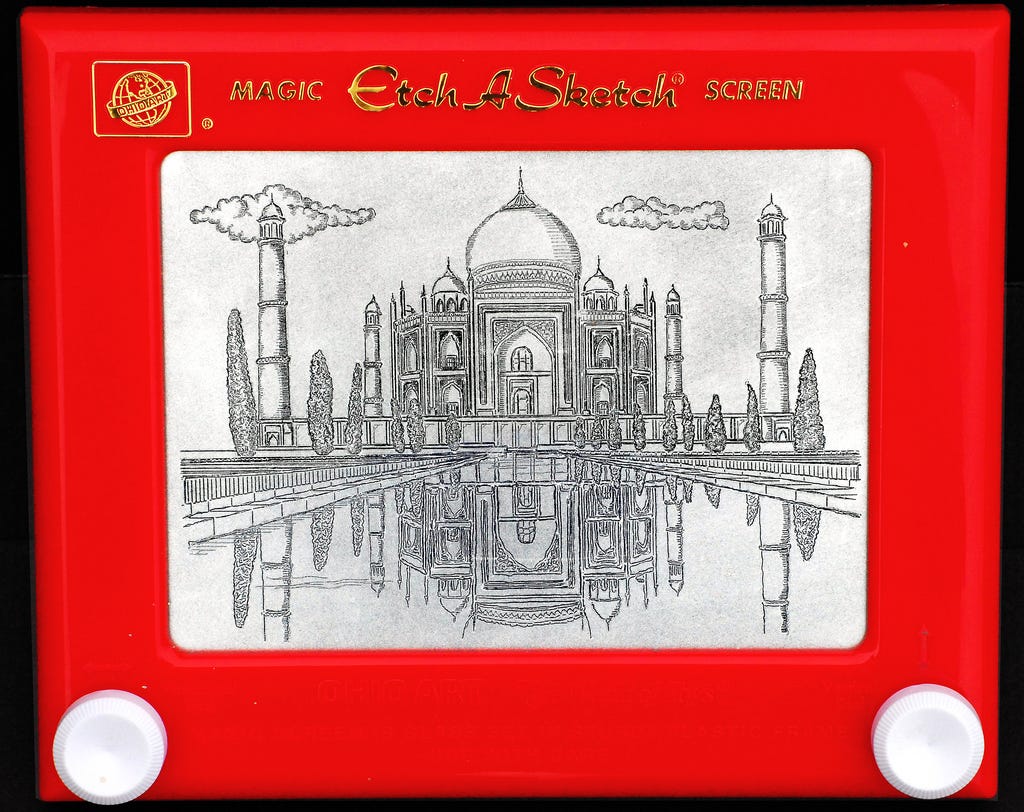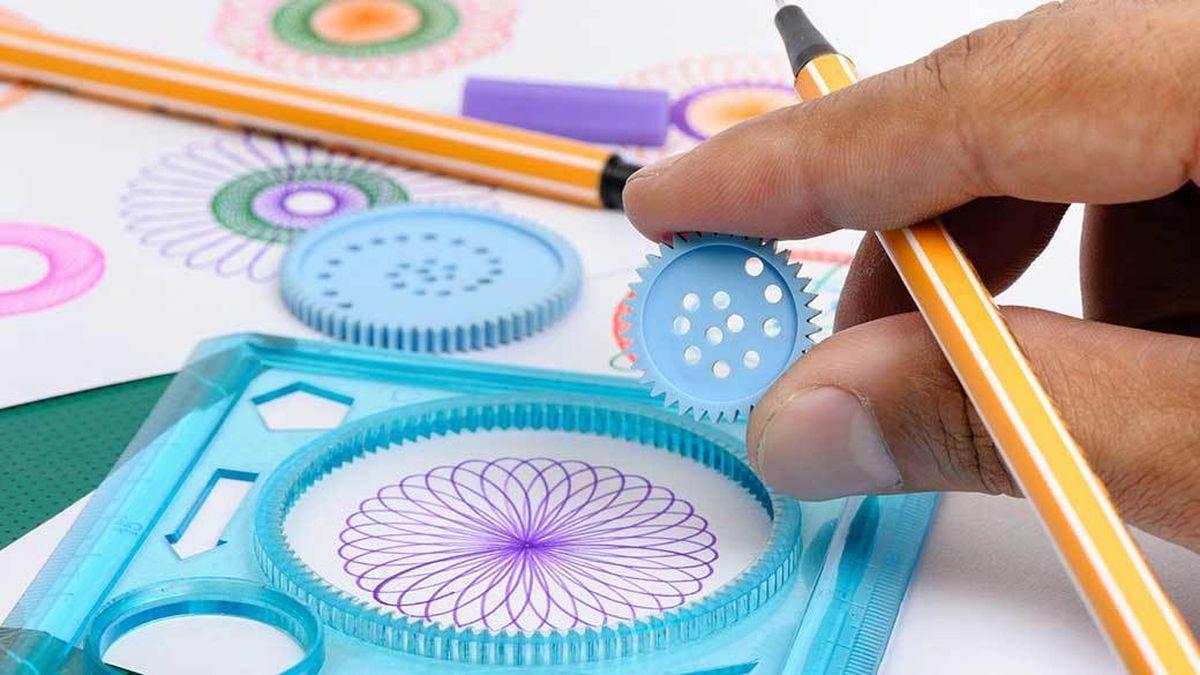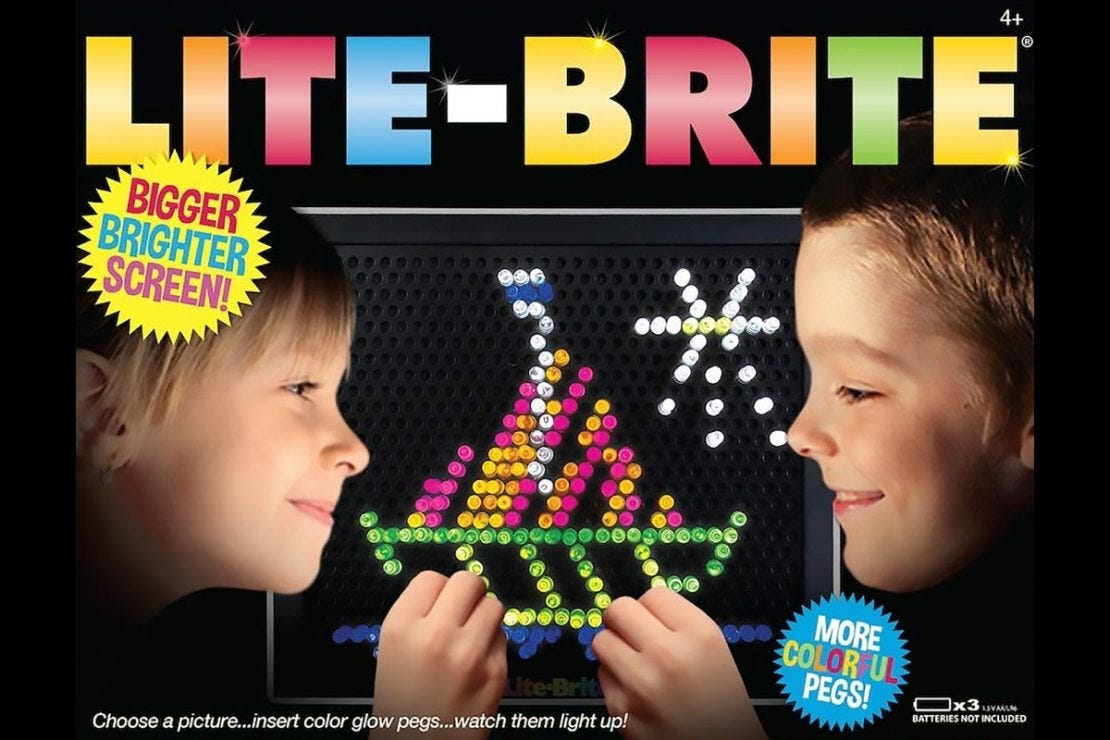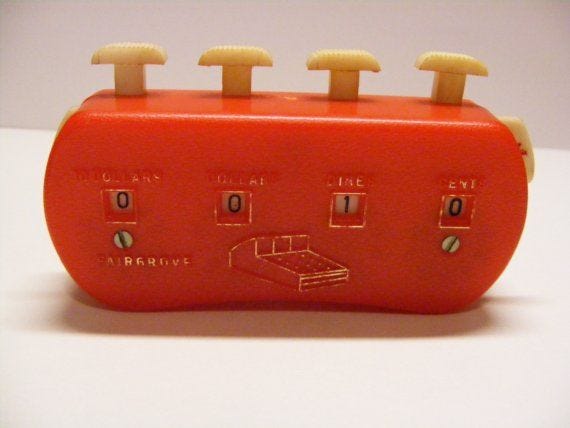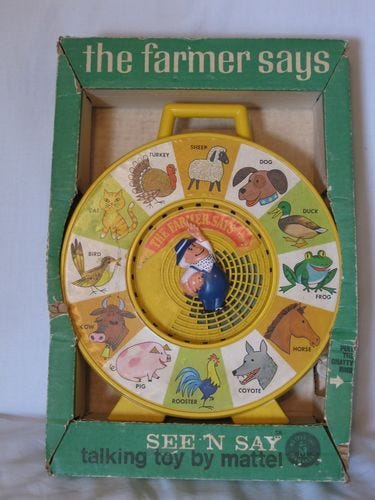When We All Pretended We Had Computers
In the 1970's, we already knew we wanted them. And the lack of chips didn't stop us.
People may be familiar with the stories about “Cargo Cults” from World War II, but the brief summary for those who don’t know (and don’t want to click the link) is: Troops occupied islands in the Pacific during the war, and often gave or traded goods to indigenous people living there. After the war the troops left, the goods stopped coming, and in some cases this spawned rituals and religious activity intended to bring back the troops and goods.
Approximations of higher technology things, such as airplanes, were sometimes constructed from simple local materials. These constructions of course had no plane-like capability, but served the immediate purpose of being a stand-in for the real thing, for use in these rituals.
I’m an old guy, but not so old that I remember World War II. But I do remember a time in the late 1960’s and early 1970’s, watching all sorts of sci fi shows featuring cool and sometimes dangerous computers. These machines had bright colorful buttons and displays, and some you could even talk to and they would answer back, like in movies like 2001: A Space Odyssey or the TV show Star Trek.
And I wanted to be the one pushing those buttons and interacting with these dangerous and colorful monsters. I was pretty sure as a kid that if they had given me the chance, I could have gotten HAL to open the pod bay doors, or convinced M-5 not to blow up the Excalibur.
But when was my M-5 tie-in going to come? Seemed like never. If you had asked me then which would be invented first, a computer you could talk to and would answer almost any question, or a matter transporter, I would have guessed the matter transporter. I was pretty wrong about that one, given how common they are today. (In my defense, one of these two has serious challenges in the physics department, which probably didn’t come into my estimations at the time)
Talking computers were of course still a ways off in the 1970s. I was pretty sure back then though that there were at least real-life computers somewhere with colorful display screens, and lots of buttons to push. Just not anywhere in my (or any other kids) house. There was a desire for the future going on here, and it created a market for consumer goods with computer tech appeal — even in the absence of any affordable electronics to drive them.
So a lot like the cargo cults, the toy market used simple, available local materials to come up with products that gave us the rough experience of computer technology, without actually having it. And then we took part in the rituals, which go on to this day.
Etch-A-Sketch
Every kid I knew in the 70’s either had an Etch-A-Sketch, or had at least used one. It was very ubiquitous, but I would not say it was loved. The cool idea that you had this graphic screen controlled by knobs appealed to me personally, as a tech-loving, computer-starved kid. Even though it was inferior in almost every way to simply drawing something on a piece of paper, something about making lines with a magic pen using remote controls was very appealing.
But this love soon gave way to frustration and boredom, owing to the problems with drawing diagonal lines, and the requirement that lines must be drawn continuously since the pen cannot be lifted from the screen. Also did I mention, dropping it?
Skills Gained: Moving a cursor. Spending a lot of time in front of a screen. Anger management after losing work in progress.
Final Fate: Alive and Well. I see Etch-A-Sketch for sale online and in big box stores, and it has a kind of throwback vibe going for it that has attracted a new set of consumers. The same things that frustrated me as a youth are now quaint, interesting limitations for the current generation of kids to experiment with. Fine by me. Just hope none of them like circles.
Spirograph
Speaking of circles: the king of the circular graphic department, (which is admittedly a pretty small department) was and maybe still is Spirograph. This toy introduced kids to the concepts of gearing and ratios, although if any of them were like me, it was really just about what a cool flower you could draw. The crisp, clean lines and exact curves produced by Spirograph looked a lot like the Oscilloscope displays I would see in movies and TV whenever they showed a computer, so I was a fan. There were some issues with this toy involving pins coming loose and paper shifting and gears going all over the place, ruining things just as you were finishing your computerized daisy. But it was fun for a bit. Really limited in scope though, so didn’t have much staying power, even in the 70’s.
Skills Gained: Appreciation of vector graphics. Working with curves and splines. Dealing with programs that crash when they are almost done.
Final Fate: Pretty much dead. Yes you can still buy Spirograph today, but I don’t think it enjoys the same iconic retro popularity of Etch-A-Sketch. You could say kids are too busy with Roblox and Fortnite to take time to play Spirograph. And I would say, I can’t blame them.
Lite-Brite
Lite-Brite, makin’ things with Liiiiiighhhtt! What a sight, makin’ things with Lite-Brite!
This relentless commercial jingle was on TV for what seemed like a billion years, and is now burned into the phosphor of my brain like the INSERT COIN text of an old Donkey Kong Arcade CRT. Given MS Paint and company were still 15 years away, this toy was the cool way to create colorful pixel art.
For those who never had the pleasure, these pixels were merely colored plastic pegs, that you stuck into a grid of holes and through a piece of opaque paper (usually black construction paper). On the other side of the paper was a light bulb, and so the light would illuminate the pegs.
Simple, but the effect to this day is uncanny. From any kind of distance, this appears as if it were a computer display of some sort. I liked this toy a lot, it allowed for creative expression and looked really cool with the lights off. But there was a big problem, apart from the dumb commercial: coming up with black construction paper. Every picture you drew needed a fresh piece of paper, and any other color besides black pretty much failed because it allowed light through.
Big-box craft stores were also not a thing yet, so you could not get like the 50-pack of just-black paper anywhere. This left you with buying a multi-color pack where you scavenged the 5 black sheets of paper out, and the 45 other-color sheets ended up at the bottom of your closet. Mistakes were also an issue, requiring you to delicately remove the grid without dropping all the pegs, and patch a bad hole.
Skills Gained: Drawing bitmaps. Understanding low screen resolution. Working with limited color palettes.
Final Fate: Still going. Again maybe not as iconic as Etch-A-Sketch, mostly due to the required setup and material use involved. But there are various, LED-powered versions of this circulating in stores, including miniature ones. And now you can just go down to Michael’s and get the huge black paper bundle if need be.
Add-A-Matic
The savvy grocery shopper of the 70’s would be found in the store with one of these little gems. Essentially a plastic, mechanical computer, the Add-A-Matic had digits for one cent, ten cents, one dollar, ten dollars (from the time when grocery bills would never exceed $99). Little plungers on top would advance the gears inside for each digit, and the crucial benefit was, there was carry-over from one digit to the next, so when you reached 9 cents and hit the button, it would return to 0, and the 10-cent digit would go to one. If you made a mistake, you’d have to hit the reset button to clear everything, and start over.
If you did things right though, you would go down the aisle and punch in each item, repeatedly hitting the plunger for each digit up to 9 times, and this thing would keep a running total of your grocery bill. Almost everybody seemed to have one, I think maybe stores even gave them out as promotions. But I’m pretty sure my mom at least would be routinely deprived of any Add-A-Matic benefits, because I would insist on playing with the thing all through any shopping trip I was brought along on.
And I do know - this one really doesn’t fit the list theme that well, since it’s not a toy, and wasn’t trying to mimic computers as much as it was a practical alternative to adding up things on paper. But I’m putting it on the list anyway because its very iconic and, well, cool (in its own way).
Skills Gained: Button mashing. Rebooting to fix problems.
Final Fate: Dead as a doornail. Not sure why doornails are deader than other things, but this one is pretty much the deadest. Portable electronic calculators starting in the late 70’s would cause these devices to spontaneously combust.
Farmer SEE ‘N SAY
Well when I said talking computers were off the table in the 70’s, maybe I was a bit premature, because while working on this list I remembered this guy: SEE-N-SAY. This toy dates back to the mid-1960’s and was a favorite of the under-six crowd, for its ability to produce animal noises on demand. (Something even the over-six crowd can appreciate, I dare say.)
Farmer SEE ‘N SAY system users would set the farmer dial to point at an animal icon on the outer ring, and then pull the string — resulting in immediate playback of the desired animal noise. Inside, a little record would spin and the selection would move the stylus to play specific track, using just the energy from a spring that was wound up from the string pull.
You might quibble that it is a stretch to consider this toy to be a stand-in for computer technology, but it was definitely marketed as something tech-based, as the mention of “talking toy” in the picture shows. That is clearly meant to entice buyers with something new they had not seen before. Maybe a bigger debate is whether animal noises even constitute talking, but you get the idea. It was a well-executed product that delivered on its farm-noise promises.
In June 1978 every SEE-N-SAY in the world was immediately outmoded however, when Texas Instruments released the Speak & Spell, a hugely-popular electronic toy that introduced the consumer world to electronic voice synthesis. But SEE-N-SAY was there first, and did its thing not only without computer chips, but without batteries.
Skills Gained: Point and pull. (precursor to point and click). Consuming media related to animal activities.
Final Fate: Still alive, somehow. I Googled around on this one and you can still buy various brand new SEE-AND-SAY toys from Fisher Price and others. (I am guessing it is the Boomer grandparents buying them, but who knows.)
So that’s my list. If you’re an old guy like me and remember something cool along these lines I missed, please share in the comments below. Or maybe you are a retro fan or collector of 70s stuff, and have something that fits the bill. If we get enough good ones I’ll publish a sequel.
In closing, I’ll say that real computers you can really talk to turned out to be way more boring than anyone would have ever guessed. In some ways these toys I listed seem more exciting to interact with, even today. Not going to say super exciting. But I do think they were good training for the computer invasion that would come in the 1980’s, if nothing else. I for one was ready.
Explore Further
Next Time: Can a tech company create a lasting legacy? Many thought so, but didn’t quite get what they expected. Some thoughts on corporate impermanence, manhole covers, and Hummel figurines coming up in: The Ephemeral Nature of Tech
The Mad Ned Memo is published on a (more or less) weekly basis, and features nerdy tales and discussions of computer technology. It frequently trends on technology-loving social media sites like Reddit or Hacker News, but you don’t have to chance missing out on an issue if you subscribe! It is cost-free and ad-free, and you can unsubscribe at any time.
The Mad Ned Memo takes subscriber privacy seriously, and does not share email addresses or other information with third parties. For more details, click here.


